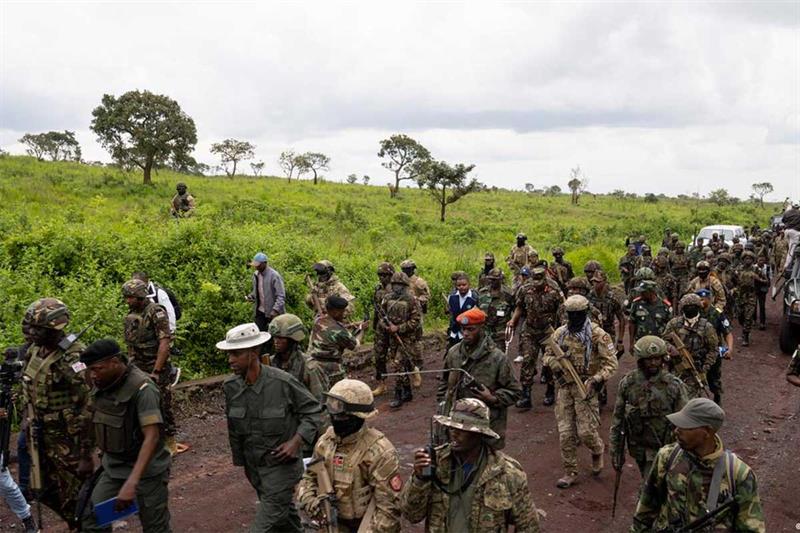The Tutsi-led M23 group’s recent battlefield successes are reminiscent of the offensive carried out by Hayat Tahrir al-Sham (HTS) and other Syrian rebels who toppled Bashar al-Assad’s regime
read more
M23 militia in Kibumba, DRC in 2022. File Image/AP
The March 23 Movement (M23) rebels, active in the Democratic Republic of Congo, seized a strategic town called Masisi, local politicians said on Sunday (January 5).
Masisi lies near the provincial capital Goma, the capital and largest city of the North Kivu, the province where the rebels are based.
The Tutsi-led M23 group’s recent battlefield successes are somewhat reminiscent of the lightning offensive carried out by Hayat Tahrir al-Sham (HTS) and other Syrian rebels in the overthrow of Bashar al-Assad’s regime.
Could the M23 rebels, allegedly backed by Rwanda, enact a repetition of the startling power-grab that happened in West Asia?
To answer this, we take a look at who the M23 rebels are and what’s common between their situation in Congo and the Syrian rebels’ circumstances.
What is M23?
M23 is a rebel military group primarily made up of ethnic Tutsis that broke away from the Congolese army a little over ten years ago due to a combination of grievances and longstanding ethnic tensions.
The rebels went on to stage a large offensive in 2012. They took over the provincial capital of Goma– the same city they are threatening now– close to the border with Rwanda.
Rwanda has been accused by Congo, and experts from UN of giving military aid to M23.
M23 rebels have claimed that they are fighting a threat from a Congolese rebel group linked to the Congo army and partly made up of ethnic Hutus who were perpetrators of the 1994 Rwandan genocide against Tutsis.
For some, the group was an expression of popular anger towards a dysfunctional Congolese government, along with issues of corruption and abuses— particularly abuses historically experienced by Congolese of Rwandan origin.
Similarities with HTS-led Syrian rebels
Backing by foreign powers: Congo’s M23 group have a lot in common with the HTS-led Syrian rebels, especially their circumstances before the toppling of Assad.
Like opposition forces in conflict-hit regions around the world, both Syrian rebels and M23 are known to have the backing of external powers.
In the case of HTS in Syria, Turkey was one of the prominent backers. Of the other rebel groups, many have had the support of Western countries at different points.
The M23 group, as previously mentioned, allegedly enjoys the backing on Rwanda. Reports in the past have also accused Uganda, which shares a border with Congo, of supporting these rebels.
Resilience: Another commonality is how both HTS and allied rebels in Syria, and M23 in Congo, have resurged after being almost decisively defeated.
In Syria, the HTS and its allies had been confined to their small Idlib province stronghold by 2018. This followed a series of military defeats—including after the chemical weapon attacks in 2013 and 2017— at the hands of the Iran and Russia-backed Assad regime.
The rebels’ resilience was apparent to the world when they mounted their lightning offensive in November 2024.
For M23, the supposed defeat had come in 2013. They had even signed a treaty with the Congo government in Nairobi, Kenya. That deal confirmed the dissolution of M23 as an armed group. Its fighters and leaders had surrendered.
However, the group resurged in 2021, accusing the Congo government of failing to hold up their end of the deal signed in nearly a decade ago. Since then, the M23 has rapidly seized vast territories in the south-east of North Kivu province.
Intention to govern: HTS-led rebels in Syria, in the run-up to their November offensive, had been making efforts to govern the territories under their control, not just terrorise them. This was part of projecting themself as a viable governing body.
M23 in North Kivu has followed a similar route.
In Congo, customary chiefs play a vital role in local land governance. They mediate conflicts, unify communities through rituals, and embody the symbolic connection between a community and its land.
According to a 2024 research report by the International Peace Information Service (IPIS), M23 has actively worked to replace customary chiefs with individuals appointed by M23, at times resorting to assassinations of local leaders.
Many Congolese believe that the group’s primary goal is to gain control over local power structures by undermining existing authorities.
In North Kivu, M23 has established mechanisms to control and extract profits from the local economy, particularly through mineral supply chains. The group operates checkpoints along major routes, imposing taxes on minerals smuggled into Rwanda and on other trade activities. This control allows M23 to consolidate power and fund its operations in the region.
Control over relatively small chunk of territory: The Idlib governorate, which remained the HTS’ stronghold despite major setbacks, occupies around three per cent of the total area of Syria.
For the HTS, Idlib provided enough of a base to launch an offensive to take ov

